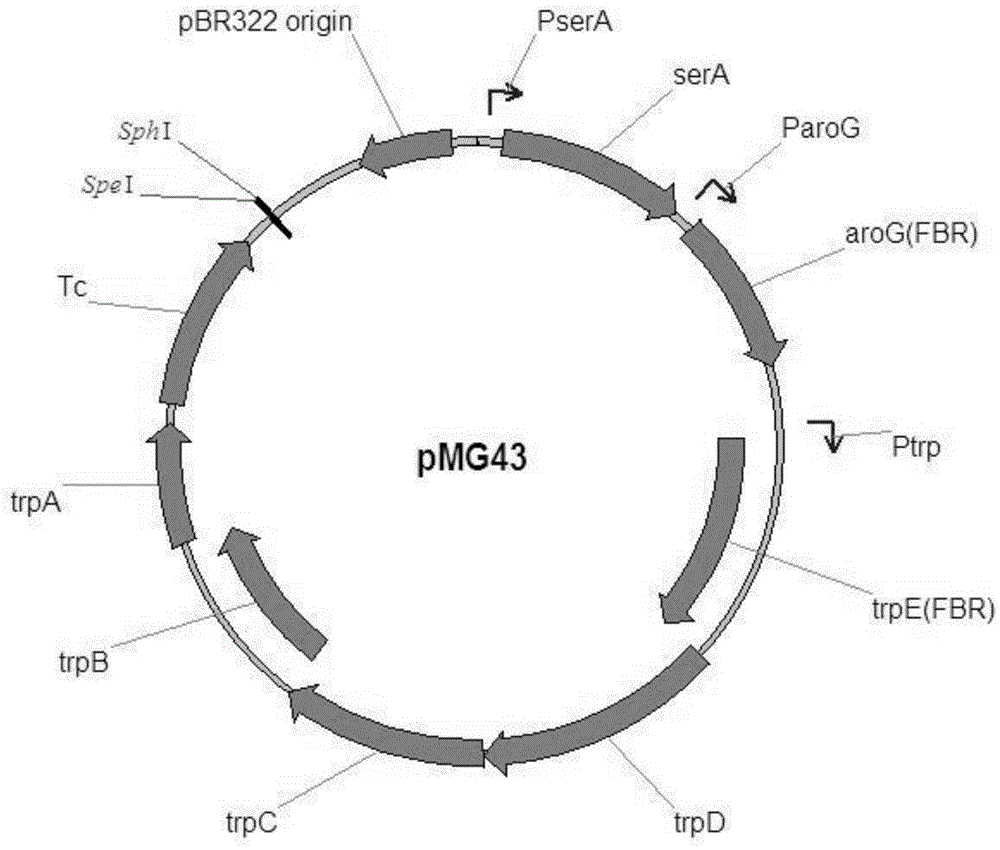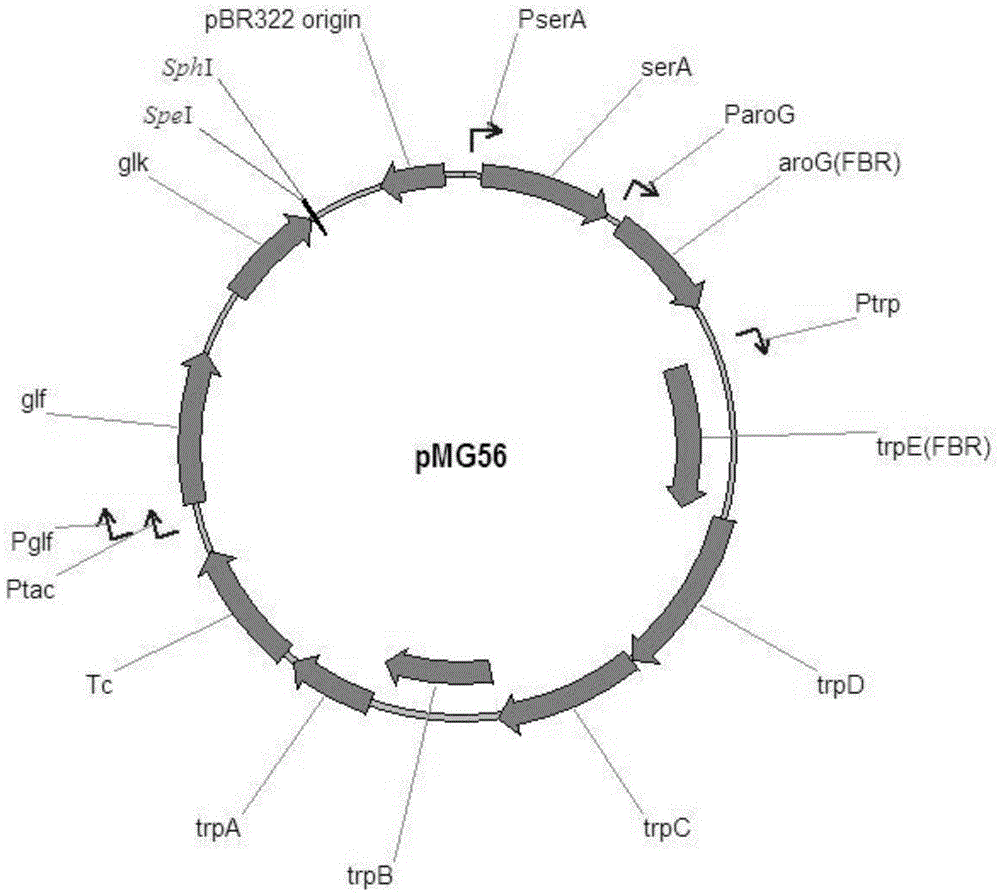L-tryptophan production genetically engineered bacterium and construction method and application thereof
A technology of genetically engineered bacteria and construction methods, applied in biochemical equipment and methods, bacteria, introduction of foreign genetic material using vectors, etc., can solve problems such as low efficiency, and achieve the effect of avoiding consumption, improving level, and improving ability
- Summary
- Abstract
- Description
- Claims
- Application Information
AI Technical Summary
Problems solved by technology
Method used
Image
Examples
Embodiment 1
[0061] Example 1: Preparation of bacterial strain SA01△ptsHIcrr with knockout of ptsH, ptsI and crr genes
[0062] 1. Preparation of mutant strain SA01△ptsHIcrr::kan
[0063] Using the plasmid pKD4 (CGSCNO.7632) as a template, use primers pts1 and pts2 to amplify the ptsHIcrr mutant gene fragment by PCR. The primer sequences are as follows:
[0064] Forward primer pts1:
[0065] 5'-CTAGACTTTAGTTCCCACAACACTAAACCTATAAGTTGGGGAAATACAATGGTGTAGGCTGGAGCTGCTTC-3' (SEQ ID NO.1)
[0066] Reverse primer pts2:
[0067] 5'-AAATGGCGCCGATGGGCGCCATTTTTCACTGCGGCAAGAATTACTTCTTGCATATGAATATCCTCCTTAG-3' (SEQ ID NO.2)
[0068] The PCR amplification reaction system is: HF buffer (without MgSO 4 ) 10 μL, dNTP (10 mM) 1 μL, High-Fidelity DNA polymerase 0.5 μL, forward primer (10 μM) 2.5 μL, reverse primer (10 μM) 2.5 μL, template 0.5 μL, add ddH 2 0 to 50 μL (the high-fidelity PCR reaction reagents used in the present invention are all purchased from NEB Company).
[0069] The PCR amplificat...
Embodiment 2
[0083] Embodiment 2: Construction of recombinant plasmid pMG56
[0084] 1. Construction of pET28-glfglk
[0085] Using plasmid pSC6.090B (ATCCNo.PTA-2578) as a template, use primers glfglk1 and glfglk2 to amplify about 2.3kb of FK1 fragment (upstream sequence of glf-glk gene), and use primers glfglk3 and glfglk4 to amplify about 1.0kb of FK2 Fragment (downstream sequence of glf-glk gene). The above PCR products were subjected to agarose gel electrophoresis and gel recovery to obtain DNA fragments of FK1 and FK2. Using the DNA fragments of FK1 and FK2 as templates, the glf-glk gene fragment of about 3.3 kb was amplified with primers lfglk1 and glfglk4. XbaI and SphI restriction enzyme sites were introduced at the 5' ends of primers glfglk1 and glfglk4, respectively, and the primer sequences were as follows:
[0086] Forward primer glfglk1:
[0087] 5′-GC TCTAGA CGACATCATAACGGTTCTG-3' (SEQ ID NO. 6)
[0088] Reverse primer glfglk2:
[0089] 5'-ACGCGCATGGGTTCCACCGATGTCAAT...
Embodiment 3
[0103] Example 3: Obtaining of L-tryptophan-producing recombinant strains
[0104] The Escherichia coli mutant SA01△ptsHIcrr obtained in Example 1 to knock out the ptsHIcrr gene was made into competent cells (for the preparation and transformation methods of competent cells, refer to page 96, chapter 1 of "Molecular Cloning Experiment Guide III"), and the 2. The obtained recombinant plasmid pMG56 was transformed into the host strain SA01ΔptsHIcrr, and the genetically engineered strain MHZ-0811 (pMG56 / SA01ΔptsHIcrr, preservation number: 11940) was obtained for the fermentation and production of L-tryptophan.
[0105] The genetically engineered strain MHZ-0811 is biologically deposited, and its relevant information is as follows:
[0106] Strain MHZ-0811: Classification and name: Escherichia coli, Escherichiacoli. It was preserved in the General Microorganism Center of China Committee for the Collection of Microorganisms on December 25, 2015, and the address is No. 1, Beichen We...
PUM
 Login to View More
Login to View More Abstract
Description
Claims
Application Information
 Login to View More
Login to View More - Generate Ideas
- Intellectual Property
- Life Sciences
- Materials
- Tech Scout
- Unparalleled Data Quality
- Higher Quality Content
- 60% Fewer Hallucinations
Browse by: Latest US Patents, China's latest patents, Technical Efficacy Thesaurus, Application Domain, Technology Topic, Popular Technical Reports.
© 2025 PatSnap. All rights reserved.Legal|Privacy policy|Modern Slavery Act Transparency Statement|Sitemap|About US| Contact US: help@patsnap.com



